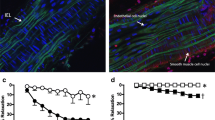Abstract
We investigated the effects of H2O2 generated by glucose (G) and glucose oxidase (GO) on the isolated rabbit aorta suspended in Krebs-Ringer solution. H2O2 produced contraction in small concentration and relaxation followed by contraction in large concentration. Contraction produced by large concentration was smaller than that produced by small concentration of H2O2. Relaxation was prevented by deendothelialization or NG-monomethyl-L-arginine, an inhibitor of nitric oxide synthesis. These results suggest that H2O2 in large concentrations produces relaxation followed by contraction, and that the relaxation is endothelium-dependent and is mediated by nitric oxide, an endothelium-derived relaxing factor.
Similar content being viewed by others
References
Prasad K, Kalra J, Chan WP: Effects of oxygen free radicals on cardiovascular function at organ and cellular levels. Am Heart J 117: 1196–1202, 1989
Prasad K, Kalra J, Chaudhary AK, Debnath D: Effect of polymorphonuclear leukocyte-derived oxygen free radicals and hypochlorous acid on cardiac function and some biochemical parameters. Am Heart J 119: 538–550, 1990
Krothuis RJ, Granger DN, Townsley MI, Taylor AE: The role of oxygen-derived free radicals in ischemia-induced increases in canine skeletal muscle vascular permeability. Circ Res 57: 599–609, 1985
Rhoades RA, Parker CS, Roepke DA, Jin N, Meiss RA: Reactive oxygen species alter contractile properties of pulmonary arterial smooth muscle. Can J Physiol Pharmacol 68: 1581–1589, 1990
Wolin MS, Rodrigues AM, Yu JM: Peroxides cause dose-dependent relaxant and constrictor responses in isolated bovine intrapulmonary arterial and venous rings. Fed Proc Am Soc Exp Biol 44: 821, 1985
Rubanyi GM, Vanhoutte PM: Oxygen derived free radicals. Endothelium and responsiveness of vascular smooth muscle. Am J Physiol 250: H815-H821, 1986
Mehta JL, Lawson DL, Yang BC, Haught WH, Hentz T: Role of superoxide radicals in anoxia and reoxygenation mediated vascular contraction. Life Sci 49: 1739–1746, 1986
Rhoades RA, Packer CS, Meiss RA: Pulmonary vascular smooth muscle contractility. Effect of free radicals. Chest 93 (Suppl. 3): 94S-95S, 1988
Burke-Wolin TM, Wolin MS: Inhibition of cGMP associated pulmonary arterial relaxation to H2O2 and O2 by ethanol. Am J Physiol 258: H1267-H1273, 1990
Thomas G, Ranwell P: Induction of vascular relaxation by hydroperoxides. Biochem Biophys Res Commun 139: 102–108, 1986
Bharadwaj L, Prasad K. Role of oxygen-derived free radicals in modulation of vascular smooth muscle tone. 36th World Congress of International College of Angiology, New York, July 2–9, 1994
Prasad K, Fuh JF: Ionic regulation of peripheral vascular tone and its interaction with norepinephrine. Can J Cardiol 1: 107–112, 1985
DeMay J, Vanhoutte PM: Role of intima in cholinergic and purinergic relaxation of isolated canine femoral arteries. J Physiol 316: 437–455, 1981
DeMay JG, Gray SD: Endothelium-dependent inhibitory effects of acetylcholine, adenosine diphosphate, thrombin and arachidonic acid in the canine femoral artery. J Pharmacol Exp Ther 222: 166–173, 1982
Prasad K, Gupta JB: Influence of hydroxyl radical on rabbit airway smooth muscle chronically exposed to H2O2 in vivo. Am J Physiol 264: L566-L574, 1993
Gupta JB, Prasad K: Mechanism of H2O2-induced modulation of airway smooth muscle. Am J Physiol 263: L714-L722, 1993
Boli R, Zhu WX, Hartley CJ, Michael LH, Repine JE, Hess ML, Kukereja RC: Attenuation of dysfunction in the post-ischemic stunned myocardium by dimethylthiourea. Circ 76: 458–468, 1987
Rees DD, Palmer RMJ, Hodson HF, Moncada S: A specific inhibitor of nitric oxide formation from L-arginine attenuates endothelium-dependent relaxation. Brit J Pharmacol 96: 418–424 1989
Daniel WW: Biostatistics: A foundation for analysis in the health sciences. New York, Wiley, 1978, p 219
Moncada S, Palmer RJ, Higgs, EA: Nitric oxide: Physiology, pathophysiology and pharmacology. Pharmacol Rev 43: 102–134, 1991
Author information
Authors and Affiliations
Rights and permissions
About this article
Cite this article
Bharadwaj, L., Prasad, K. Mediation of H2O2-induced vascular relaxation by endothelium-derived relaxing factor. Mol Cell Biochem 149, 267–270 (1995). https://doi.org/10.1007/BF01076587
Issue Date:
DOI: https://doi.org/10.1007/BF01076587




